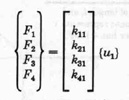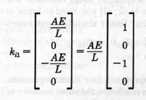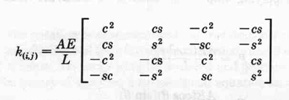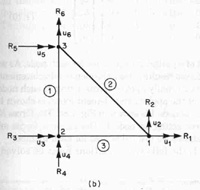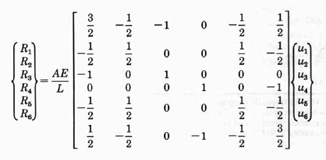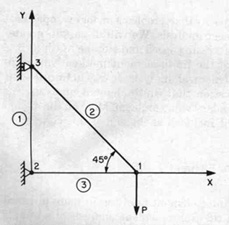
Finite Element Analysis (FEA) is a numerical method which provides solutions to problems that would otherwise be difficult to obtain. In terms of fracture, FEA most often involves the determination of stress intensity factors. FEA, however, has applications in a much broader range of areas; for example, fluid flow and heat transfer. While this range is growing, one thing will remain the same: the theory of how the method works.
The most efficient method of learning is by example. Therefore, I would like to present to you a simple FEA problem: the case of a three-member truss. The method of solution to this problem should demonstrate the basic concepts of FEA which are present in any analysis.
Before introducing specific quantities for our example, let's first take a look at our structure:

The overall objective of our analysis will be to determine the displacements of the truss members given the load P.
The first thing we must do is choose our elements. For our situation this is easy: each truss member should be one element. Further division would accomplish nothing, since each truss member can only support axial loads.
Let us now examine a single truss member:
Nodes
are located at each end of the bar, each of which can have
displacements in the x and y directions. The displacements are
denoted u1, u2, u3, and u4.
Corresponding forces due to these displacements are F1,
F2, F3, and F4. The bar has
a uniform cross-sectional area A and Young's Modulus E. The general
relationship between force and displacement is Fi =
kij*uj, where Fi is the force
in direction i, uj is the displacement in direction
j, and kij is the "stiffness" coefficient
relating Fi to uj. In our particular example
of a horizontal truss element, we have the following system of
equations:
F1 = k11u1 + k12u2
+ k13u3 + k14u4
F2 = k21u2 + k22u2
+ k23u3 + k24u4
F3 = k31u1 + k32u2
+ k33u3 + k34u4
F4 = k41u1 + k42u2
+ k43u3 + k44u4
The matrix kij is called the "
stiffness matrix."
It is the matrix which defines the geometric and material properties
of the bar. Stiffness matrices are a fundamental part of FEA.
These matrices always define inherent properties of the system
being studied. For the system at hand, we need to determine the
stiffness matrix. The way we will go about doing this may seem a
little strange at first, but try to follow the reasoning as it does make
sense. Let's begin by assuming u1 = 1 and u2 = u3
= u4 = 0. Then our matrix takes the form:
Each force Fi is equal to kj1. Now, recall
from mechanics of materials that the displacement of a rod is
given by u = FL/AE. With displacement u1 = 1, force
1 is F1 = AE/L. To maintain equilibrium, we must also
have a force F3 = -AE/L:
Since our Fi's equal our ki1's, we have:
It important to remember that our element can support only axial
loads. Therefore, displacements u2 and u4
can not give rise to stresses in the bar since these displacements
are perpendicular to the axis of the bar. Thus, the stiffness
coefficients of these displacements must be zero: ki2
= ki4 = 0. Finally, a displacement u3 =
1 will result in forces just opposite to those from u1
= 1, so ki3 = -ki1. Our stiffness matrix is:
It must be emphasized that the stiffness matrix just derived
is only valid for bars parallel to the x-axis. Through a similar
derivation it can be shown that the stiffness matrix for any bar
oriented at an angle "theta" to the x-axis is:
where c = cos"theta" and s = sin"theta".
Note that when "theta" = 0, this stiffness
matrix reduces to the one we derived for a horizontal bar.
Now knowing the stiffness matrix for any axially loaded bar,
we can apply it to a real situation with specific quantities.
Consider the following truss:
The displacements and external forces are:
Note the symbols we are using: R is an external force on the truss;
F is an internal force resulting from the stresses imposed on
the structure during a displacement. Knowing the orientations
of each element, we can set up matrices for them. Using "theta"
= 90 degrees for element 1, "theta" = 135 degrees for element 2,
and "theta" = 0 degrees for element 3 we obtain the following matrices:
We can now generate a set of equilibrium equations for each node.
Consider the following figure:
The nodal forces (resulting from element displacements) must be
equal and opposite to the externally applied forces. Note that
we have all forces drawn in positive x and y directions. Thus,
for equilibrium at node 1:
y - direction: R1 - F1(element3) - F1(element2)
= 0
R2 = AE/L ( -u1/2 + u2/2 + u5/2
- u6/2 ).
R4 = AE/L ( u4 - u6 )
R5 = AE/L ( -u1/2 + u2/2 + u5/2
- u6/2 )
R6 = AE/L ( u1/2 - u2/2 - u4
- u5/2 +3u6/2 )
Now recall what we are trying to do here: given a load P, we
want to solve for the displacements at each node. Observing that node 2 is pinned
and that node 3 is on a roller, the displacements u3, u4, and
u5 must equal 0. These values are quite important because without them
we wouldn't be able to solve the problem. As a matter of fact, values such
as these are always needed in finite element analyses; they are
known as "
boundary conditions." Next, we must state the
reactions which are known from our particular loading. We can see from the truss
that R1 = 0, R2 = -P, and R6 = 0.
Entering the known displacements and reactions into our
matrix we get:
This matrix reduces to:
We can now finish our problem by solving this matrix for u1,
u2, and u6:
u2 = -4PL/AE
u6 = -PL/AE
For Virginia Tech engineering students interested in FEA, one undergraduate
course is available: ESM 4734 - An Introduction to the Finite Element Method. In
this course, students study the theory and application of FEA to problems
in various fields of engineering and applied sciences. The pre-requisite
for the course is: ESM 2074 - Computational Methods.
References
Finite Element Analysis on Microcomputers, Nicholas M. Baran,
McGraw-Hill Book Company, 1988.
Finite Element Primer, Bruce Irons and Nigel Shrive,
John Wiley & Sons, Inc., 1983.
Submitted by Jason Midkiff
Virginia Tech Materials Science and Engineering
http://www.eng.vt.edu/eng/materials/classes/MSE2094_NoteBook/97ClassProj/num/midkiff/theory.html
Last updated: 4/29/97
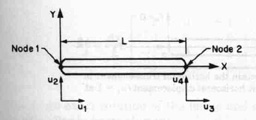 (more info. on nodes)
(more info. on nodes)

